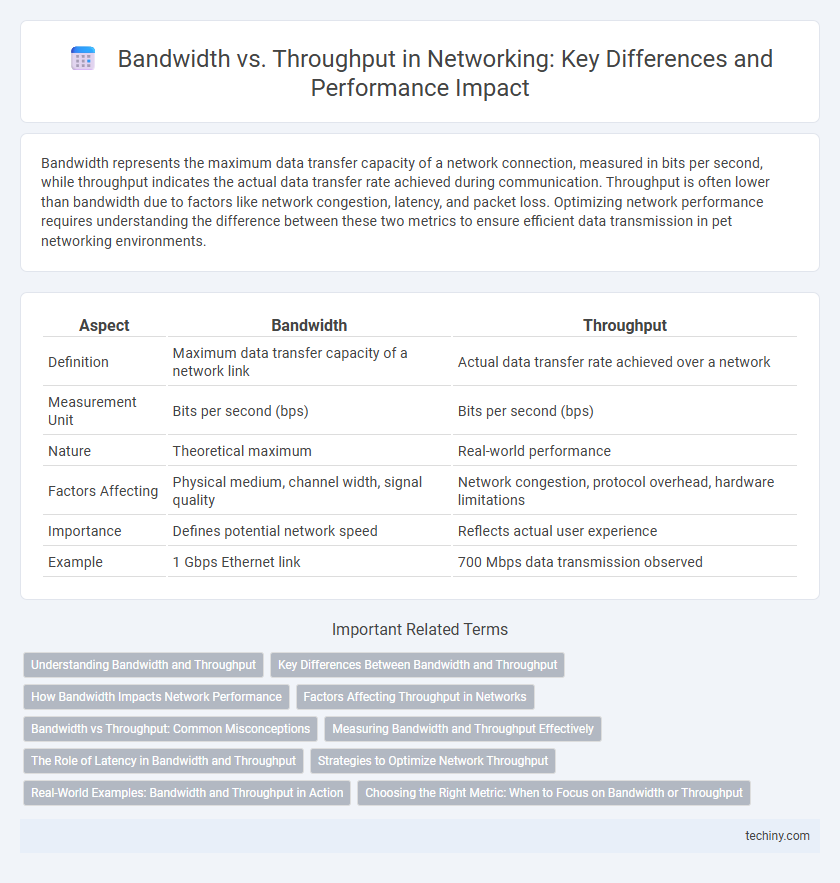Bandwidth represents the maximum data transfer capacity of a network connection, measured in bits per second, while throughput indicates the actual data transfer rate achieved during communication. Throughput is often lower than bandwidth due to factors like network congestion, latency, and packet loss. Optimizing network performance requires understanding the difference between these two metrics to ensure efficient data transmission in pet networking environments.
Table of Comparison
| Aspect | Bandwidth | Throughput |
|---|---|---|
| Definition | Maximum data transfer capacity of a network link | Actual data transfer rate achieved over a network |
| Measurement Unit | Bits per second (bps) | Bits per second (bps) |
| Nature | Theoretical maximum | Real-world performance |
| Factors Affecting | Physical medium, channel width, signal quality | Network congestion, protocol overhead, hardware limitations |
| Importance | Defines potential network speed | Reflects actual user experience |
| Example | 1 Gbps Ethernet link | 700 Mbps data transmission observed |
Understanding Bandwidth and Throughput
Bandwidth represents the maximum capacity of a network connection to transmit data, measured in bits per second (bps). Throughput indicates the actual rate at which data is successfully transferred over the network, often lower than bandwidth due to factors like latency, protocol overhead, and network congestion. Understanding the distinction between bandwidth as potential speed and throughput as real-world performance is critical for optimizing network efficiency and diagnosing connectivity issues.
Key Differences Between Bandwidth and Throughput
Bandwidth represents the maximum data transfer capacity of a network channel, measured in bits per second (bps), defining the potential speed ceiling. Throughput is the actual rate of successful data transfer across the network, influenced by factors like latency, packet loss, and network congestion. Key differences include bandwidth as theoretical maximum capacity, while throughput reflects real-world performance and efficiency.
How Bandwidth Impacts Network Performance
Bandwidth defines the maximum data transfer capacity of a network link, directly influencing how much information can be transmitted over a connection at any given moment. Higher bandwidth allows for faster data transfer rates, reducing latency and improving overall network responsiveness, especially in high-demand environments like video streaming or large file transfers. However, throughput, the actual achieved data transfer rate, can be limited by factors such as network congestion, hardware inefficiencies, and protocol overhead, meaning high bandwidth alone does not guarantee optimal network performance.
Factors Affecting Throughput in Networks
Network throughput is influenced by factors such as latency, packet loss, and network congestion, which limit the actual data transfer rate despite available bandwidth. Hardware limitations including router processing power and interface speed also impact throughput efficiency. Protocol overhead and interference in wireless networks further reduce effective throughput compared to theoretical bandwidth capacity.
Bandwidth vs Throughput: Common Misconceptions
Bandwidth refers to the maximum data transfer capacity of a network connection, while throughput measures the actual data successfully transmitted over a given time. A common misconception is assuming higher bandwidth always leads to higher throughput, but factors like network congestion, latency, and packet loss significantly impact throughput. Understanding the difference between these metrics is crucial for accurately evaluating network performance and troubleshooting connectivity issues.
Measuring Bandwidth and Throughput Effectively
Measuring bandwidth involves assessing the maximum data transfer rate a network connection can handle, typically expressed in bits per second (bps), using tools like speed tests or network analyzers. Throughput measurement reflects the actual data transfer rate achieved, factoring in real-world conditions such as latency, packet loss, and network congestion, which can be captured using traffic monitoring software and performance metrics. Effective measurement requires distinguishing between theoretical capacity (bandwidth) and observed performance (throughput) to optimize network configurations and ensure reliable data transmission.
The Role of Latency in Bandwidth and Throughput
Latency significantly influences both bandwidth and throughput by determining the delay before data transfer begins, impacting the overall network performance. High latency can cause underutilization of available bandwidth, reducing effective throughput despite having sufficient bandwidth capacity. Optimizing latency is essential to maximize throughput, particularly in high-bandwidth environments where delays can create bottlenecks and degrade data transmission efficiency.
Strategies to Optimize Network Throughput
Optimizing network throughput involves implementing strategies such as traffic shaping to prioritize critical data packets and reduce congestion, along with increasing bandwidth capacity to handle higher data volumes efficiently. Employing Quality of Service (QoS) protocols ensures that latency-sensitive applications receive adequate resources, minimizing packet loss and delays. Network administrators also benefit from regularly monitoring performance metrics and upgrading hardware to maintain optimal throughput aligned with bandwidth capabilities.
Real-World Examples: Bandwidth and Throughput in Action
Bandwidth defines the maximum data transfer rate of a network, measured in bits per second, while throughput reflects the actual achieved data transfer rate during real-world usage. For example, a fiber-optic connection might have a bandwidth of 1 Gbps, but throughput can drop to 700 Mbps due to network congestion, hardware limitations, or protocol overhead. Streaming a 4K video on a home Wi-Fi network illustrates the difference, where bandwidth indicates the potential speed and throughput determines the video's smoothness and buffering experience.
Choosing the Right Metric: When to Focus on Bandwidth or Throughput
Bandwidth measures the maximum data transfer capacity of a network, while throughput represents the actual data successfully transmitted over a period. Choose bandwidth when planning network capacity or upgrading infrastructure to ensure potential performance meets demand. Focus on throughput for evaluating network efficiency, identifying bottlenecks, and optimizing real-time user experience.
Bandwidth vs Throughput Infographic

 techiny.com
techiny.com